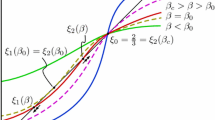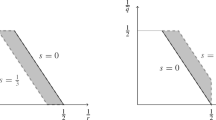Abstract
For a smooth bounded domain \(G\subset {{\mathbb {R}}}^3\), we consider maps \(n:{\mathbb {R}}^3\setminus G\rightarrow {\mathbb {S}}^2\) minimizing the energy \(E(n)=\int _{{\mathbb {R}}^3{\setminus } G}|\nabla n|^2 +F_s(n_{\lfloor \partial G})\) among \({\mathbb {S}}^2\)-valued map such that \(n(x)\approx n_0\) as \(|x|\rightarrow \infty \). This is a model for a particle G immersed in nematic liquid crystal. The surface energy \(F_s\) describes the anchoring properties of the particle and can be quite general. We prove that such minimizing map n has an asymptotic expansion in powers of 1/r. Further, we show that the leading order 1/r term is uniquely determined by the far-field condition \(n_0\) for almost all \(n_0\in {\mathbb {S}}^2\), by relating it to the gradient of the minimal energy with respect to \(n_0\). We derive various consequences of this relation in physically motivated situations: when the orientation of the particle G is stable relative to a prescribed far-field alignment \(n_0\); and when the particle G has some rotational symmetries. In particular, these corollaries justify some approximations that can be found in the physics literature to describe nematic suspensions via a so-called electrostatics analogy.
Similar content being viewed by others
References
Alama, S., Bronsard, L., Galvão Sousa, B.: Weak anchoring for a two-dimensional liquid crystal. Nonlinear Anal. 119, 74–97 (2015)
Alama, S., Bronsard, L., Golovaty, D., Lamy, X.: Saturn ring defect around a spherical particle immersed in a nematic liquid crystal. Calc. Var. Part. Differ. Equ. 60, 1–50 (2021)
Alama, S., Bronsard, L., Lamy, X.: Minimizers of the Landau-de Gennes energy around a spherical colloid particle. Arch. Ration. Mech. Anal. 222(1), 427–450 (2016)
Alama, S., Bronsard, L., Lamy, X.: Spherical particle in nematic liquid crystal under an external field: the Saturn ring regime. J. Nonlinear Sci. 28(4), 1443–1465 (2018)
Alouges, F., Chambolle, A., Stantejsky, D.: The Saturn ring effect in nematic liquid crystals with external field: effective energy and hysteresis. Arch. Ration. Mech. Anal. 241(3), 1403–1457 (2021)
Alouges, F., Chambolle, A., Stantejsky, D.: Convergence to line and surface energies in nematic liquid crystal colloids with external magnetic field. ar**v:2202.10703 (2022)
Bella, P., Giunti, A., Otto, F.: Effective multipoles in random media. Comm. Partial Differ. Equ. 45(6), 561–640 (2020)
Berlyand, L., Cioranescu, D., Golovaty, D.: Homogenization of a Ginzburg–Landau model for a nematic liquid crystal with inclusions. J. Math. Pures Appl. 84, 97–136 (2005)
Berlyand, L., Khruslov, E.: Ginzburg–Landau model of a liquid crystal with random inclusions. J. Math. Phys. 46(9), 095107 (2005)
Bethuel, F.: On the singular set of stationary harmonic maps. Manuscr. Math. 78(4), 417–443 (1993)
Brochard, F., de Gennes, P.G.: Theory of magnetic suspensions in liquid crystals. J. Phys. Fr. 31(7), 691–708 (1970)
Calderer, M.C., DeSimone, A., Golovaty, D., Panchenko, A.: An effective model for nematic liquid crystal composites with ferromagnetic inclusions. SIAM J. Appl. Math. 74(2), 237–262 (2014)
Canevari, G., Zarnescu, A.: Design of effective bulk potentials for nematic liquid crystals via colloidal homogenisation. Math. Models Methods Appl. Sci. 30(2), 309–342 (2020)
Canevari, G., Zarnescu, A.: Polydispersity and surface energy strength in nematic colloids. Math. Eng. 2(2), 290–312 (2020)
Dipasquale, F., Millot, V., Pisante, A.: Torus-like solutions for the Landau-de Gennes model. I: The Lyuksyutov regime. Arch. Ration. Mech. Anal. 239(2), 599–678 (2021)
Gilbarg, D., Trudinger, N.: Elliptic partial differential equations of second order. Classics in Mathematics, (Springer, Berlin, 2001), Reprint of the 1998 edition
Hardt, R., Kinderlehrer, D., Lin, F.-H.: Existence and partial regularity of static liquid crystal configurations. Comm. Math. Phys. 105(4), 547–570 (1986)
Hardt, R., Kinderlehrer, D., Lin, F.-H.: Stable defects of minimizers of constrained variational principles. Ann. Inst. H. Poincare Anal. Non Linear 5(4), 297–322 (1988)
Hardt, R., Kinderlehrer, D., Lin, F.H. (1990) The variety of configurations of static liquid crystals. Var. Methods Proc. Conf. Paris Prog. Nonlinear Differ. Equ. Appl. 4: 115–131
Kuksenok, O.V., Ruhwandl, R.W., Shiyanovskii, S.V., Terentjev, E.M.: Director structure around a colloid particle suspended in a nematic liquid crystal. Phys. Rev. E 54, 5198–5203 (1996)
Lavrentovich, O.D.: Design of nematic liquid crystals to control microscale dynamics. Liq. Cryst. Rev. 8(2), 59–129 (2020)
Lubensky, T.C., Pettey, D., Currier, N., Stark, H.: Topological defects and interactions in nematic emulsions. Phys. Rev. E 57, 610–625 (1998)
Luckhaus, S.: Partial Hölder continuity for minima of certain energies among maps into a Riemannian manifold. Indiana Univ. Math. J. 37(2), 349–367 (1988)
Muševič, I.: Interactions, topology and photonic properties of liquid crystal colloids and dispersions. Eur. Phys. J. Spec. Top. 227(17), 2455–2485 (2019)
Pacard, F., Rivière, T.: Linear and nonlinear aspects of vortices, vol. 39 of Progress in Nonlinear Differential Equations and their Applications, (Birkhäuser Boston, Inc., Boston, MA, 2000), The Ginzburg-Landau model
Ramaswamy, S., Nityananda, R., Raghunathan, V.A., Prost, J.: Power-law forces between particles in a nematic. Mol. Cryst. Liq. Cryst. 288(1), 175–180 (1996)
Schoen, R.: Analytic aspects of the harmonic map problem. In Seminar on nonlinear partial differential equations, (Springer, New York, 1983) pp. 321–358
Schoen, R., Uhlenbeck, K.: A regularity theory for harmonic maps. J. Differ. Geom. 17(2), 307–335 (1982)
Schoen, R.M.: Uniqueness, symmetry, and embeddedness of minimal surfaces. J. Differ. Geom. 18(4), 791–809 (1983)
Stein, E. M., Weiss, G.: Introduction to Fourier analysis on Euclidean spaces. In: Princeton Mathematical Series, (Princeton University Press, Princeton, 1971)
Acknowledgements
S.A. and L.B. were supported via an NSERC (Canada) Discovery Grant. X.L. received support from ANR project ANR-18-CE40-0023. The work of R.V. was partially supported by a grant from the Simons Foundation (award # 733694) and an AMS-Simons travel award. We wish to thank the anonymous referees for the many substantial improvements they suggested.
Author information
Authors and Affiliations
Corresponding author
Additional information
Communicated by Alain Goriely.
Publisher's Note
Springer Nature remains neutral with regard to jurisdictional claims in published maps and institutional affiliations.
Appendix A: Decay Estimates for Poisson’s Equation
Appendix A: Decay Estimates for Poisson’s Equation
We collect here some folklore decay estimates for Poisson’s equation. For the reader’s convenience, we include a self-contained proof (similar arguments can be found, e.g. in (Pacard and Rivière 2000, § 2.2.3) for Hölder decay at the origin). The elementary arguments we present here do not seem to apply directly for general systems as in Remark 1, in that case one should refer to (Bella et al. 2020, § 5-6).
Lemma A.1
Let \(d\ge 3\), \(\gamma >d-2\), \(\gamma \notin {\mathbb {N}}\), and f a function in \({{\mathbb {R}}}^d\setminus B_1\) satisfying
Then, there exists a function u such that \(\Delta u =f\) in \({{\mathbb {R}}}^d\setminus B_1\) and
where the constant depends only on d and \(\gamma \).
Note that (A.1) does not determine u uniquely, as we may add any faster-decaying harmonic terms to u without changing the equation \(\Delta u=f\), but the proof does determine an explicit right inverse \(f\mapsto u\) to the Laplacian in that decay range.
We will obtain Lemma A.1 as a consequence of an \(L^2\) version of it, that we state now.
Lemma A.2
Let \(d\ge 3\), \(\gamma >d-2\), \(\gamma \notin {\mathbb {N}}\), and f a function in \({{\mathbb {R}}}^d\setminus B_1\) satisfying
Then, there exists a function u such that \(\Delta u =f\) in \({{\mathbb {R}}}^d\setminus B_1\) and
where the implicit constant depends only on d and \(\gamma \).
Before proving Lemma A.2, we explain why, together with rescaled elliptic estimates, it implies Lemma A.1.
Proof of Lemma A.1
The assumption on f implies that it satisfies the \(L^2\) decay in the assumption of Lemma A.2, so we obtain u such that \(\Delta u=f\) in \({{\mathbb {R}}}^d\setminus B_1\) and
and the pointwise bound (A.1) in the conclusion of Lemma A.1 follows from rescaled elliptic estimates. Explicitly, consider \({\hat{u}}({\hat{x}})=u(R{\hat{x}})\) which solves \(\Delta {\hat{u}} = {\hat{f}}\), where \({\hat{f}}({\hat{x}}):=R^2 f(R{\hat{x}})\), then from interior elliptic estimates (see, e.g. Gilbarg and Trudinger (2001)) we have
from which, scaling back, we infer (A.1).
Next, we prove Lemma A.2. Before doing so, we recall some facts concerning spherical harmonics (that is, homogeneous harmonic polynomials), referring the reader to Stein and Weiss (1971) for details. The Laplace–Beltrami operator on \({\mathbb {S}}^{d-1}\) diagonalizes as
The set \(\lbrace \lambda _j\rbrace _{j\in {\mathbb {N}}}\) coincides with \(\lbrace k^2 + k(d-2)\rbrace _{k\in {\mathbb {N}}}\). The eigenfunctions corresponding to \(k^2 + k(d-2)\) span the homogeneous harmonic polynomials of degree k. We choose them normalized in \(L^2(\mathbb S^{d-1})\) so they form an orthonormal Hilbert basis of this space. For a \(W^{2,2}_{loc}\) function \(w:(0,\infty ) \rightarrow \mathbb {R}\), we have
The solutions of \({\mathcal {L}}_j w=0\) are linear combinations of \(r^{\gamma _j^+}\) and \(r^{-\gamma _j^-}\), where \(\gamma _j^\pm \ge 0\) are given by
The decay rate \(\gamma >d-2\), \(\gamma \notin {\mathbb {N}}\), is fixed, and we denote by \(j_0=j_0(\gamma )\) the integer \(j_0\ge 0\) such that
Proof of Lemma A.2
We extend f to be defined in \({{\mathbb {R}}}^d\), with the property that
and will construct a function u such that \(\Delta u=f\) in \({{\mathbb {R}}}^d\setminus \lbrace 0\rbrace \). The function \(f\in L^2({{\mathbb {R}}}^d)\) admits a spherical harmonics expansion
and the decay assumption (A.2) on f amounts to
We define u as
where \(u_j\in W^{2,2}_{loc}(0,\infty )\) satisfy
To write down an explicit formula for \(u_j\), we rewrite \(\mathcal L_j\), defined in (A.4), as
and define
This is well defined because for any \(t >0\) using Cauchy–Schwarz, (A.5) with the choice \(R = t\), and the fact that \(\gamma _j^-\ge d-2>0\), we can estimate the inner integral by
Furthermore, as \(t\mapsto t^{2\gamma _j^- + 1 - d }t^{d-2-\gamma - \gamma _j^-} = t^{\gamma _j^--\gamma -1}\) is integrable near \(\infty \) if \(\gamma _j^-<\gamma \), i.e. if \(j\le j_0\); and is integrable near 0 if \(\gamma _j^->\gamma \), i.e. if \(j\ge j_0 +1\), the functions \(u_j\) in (A.6) are well-defined.
Let \(j\le j_0\) and set
so that \(2\gamma +1 - d>\alpha > 2\gamma _j^-+1 - d\). By (A.7) and Cauchy–Schwarz, we have
where in the last line, we used that \(\gamma _j^- \geqslant d-2\) so that \( 2 + 2\gamma _j^- - d \geqslant d-2,\) and that \(\gamma + \gamma _{j_0}^- - 2\gamma _{j}^- \geqslant \gamma - \gamma _{j_0}^-,\) when \(j \leqslant j_0.\) Summing and using (A.5), we deduce
Similarly, for \(j\ge j_0+1\) we set
which satisfies \(2\gamma +1 - d<\beta < 2\gamma _j^-+1 - d\). Using (A.7) and Cauchy–Schwarz, we find
so that, we similarly obtain from (A.5) that
We conclude that
Therefore, since \(\gamma > d-2\),
which proves (A.3).
Rights and permissions
Springer Nature or its licensor (e.g. a society or other partner) holds exclusive rights to this article under a publishing agreement with the author(s) or other rightsholder(s); author self-archiving of the accepted manuscript version of this article is solely governed by the terms of such publishing agreement and applicable law.
About this article
Cite this article
Alama, S., Bronsard, L., Lamy, X. et al. Far-Field Expansions for Harmonic Maps and the Electrostatics Analogy in Nematic Suspensions. J Nonlinear Sci 33, 39 (2023). https://doi.org/10.1007/s00332-023-09895-0
Received:
Accepted:
Published:
DOI: https://doi.org/10.1007/s00332-023-09895-0




